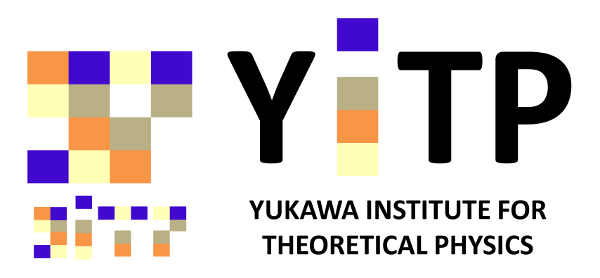This workshop is (mainly) held at Research Building.
Useful maps are available
here.
K202 is available for the discussion room.
All seminars are held at K102.
Week1 (Sep.4 - Sep.8)
| 4 (Mon) |
5 (Tue) |
6 (Wed) |
7 (Thu) |
8 (Fri) |
15:00 - 15:30
Coffee Break
15:30 - 16:30
Seminar
K. Koyama [pdf]
|
15:00 - 15:30
Coffee Break
15:30 - 16:30
Seminar
E. Linder [pdf]
|
15:00 - 15:30
Coffee Break
15:30 - 16:30
Seminar
G. Zhao [pdf]
|
Workshop Day1
Room: K206
|
Workshop Day2
Room: YH110
(Panasonic Auditorium)
Banquet
Room: K102
|
Week2 (Sep.11 - Sep.15)
| 11 (Mon) |
12 (Tue) |
13 (Wed) |
14 (Thu) |
15 (Fri) |
10:30 - 11:00
Coffee Break
11:00 - 12:00
Seminar
N. Kaiser [pdf]
15:00 - 15:30
Coffee Break
15:30 - 16:30
Seminar
M. Takada [pdf]
|
15:00 - 15:30
Coffee Break
15:30 - 16:30
Seminar
D. Bacon [pdf]
|
|
15:00 - 15:30
Coffee Break
15:30 - 16:30
Seminar
D. Bacon [pdf]
|
10:30 - 11:00
Coffee Break
11:00 - 12:00
Seminar
D. Bacon [pdf]
15:00 - 15:30
Coffee Break
15:30 - 16:30
Seminar
Y-S. Song [pdf]
|
Title and Abstract for Seminars (60min)
Perturbative approaches to the redshift space distortions
Kazuya Koyama (ICG)
The measurements of the growth rate of structure formation provide valuable information
about the nature of the cosmic acceleration.
In my talk, I will discuss the recent developments of perturbation theory based approaches
to model the redshift space power spectrum and correlation function and their application
to general dark energy and modified gravity models. I also touch upon the effective field
theory approach of larger scale structure.
Modifying Gravity to be Useful to Observers
Eric Linder (KASI)
Modifying gravity in theory is relatively easy, but learning about
gravity from observational data is hard. Constraints tend to apply to
one particular theory of gravity, with one particular functional
form, with one particular set of parameters. With classes such as Horndeski
gravity or an effective field theory approach, there are four or more
free functions of time in addition to the cosmic expansion history, and
no clear guide to their parametrization. We instead focus on observational
aspects of cosmic structure growth and ask whether there are unbiased
signatures of modified gravity that can be constrained by future surveys.
Understanding the cosmic acceleration using large galaxy surveys
Gong-bo Zhao (NAOC)
The origin of the cosmic acceleration has been one of the key problems to solve in modern sciences.
According to what we know so far, it might be due to the effect of dark energy, or to our
misunderstanding of gravity. In this talk, I will explore the possibilities and practicalities
of tackling this challenging cosmic acceleration problem using large scale structure surveys
including BOSS, eBOSS and DESI. I will also address the issue of tension among different
kinds of recent astronomical observations, and offer a solution to release the tension
using the dynamical dark energy.
Why there is no Newtonian backreaction
Nick Kaiser (IfA)
In the conventional framework for cosmological dynamics it is assumed
that there is a "scale factor" a(t) that obeys the Friedmann equation
for a perfectly homogeneous universe, while particles move with
`peculiar' motions that are driven by the gravity associated with
the spatial fluctuations of the density. This gives the conventional
equations of particle motion that are commonly solved in numerical
N-body simulations. It has sometimes been questioned whether this
is legitimate and whether in fact the emergence of non-linear
structure has some `backreaction' on the global expansion rate. If
so this could have significant implications for cosmology. It has
been suggested recently that this is indeed the case, and this allows
the successes of `concordance cosmology' without the need for dark
energy. Here I argue that, in the Newtonian limit, which should
be a good approximation in the low-z universe where the need for
dark energy is already apparent, one should not think about there
being a background equation of motion for a(t) and a separate set
of equations for the motions of particles relative to this background.
Rather there are just equations of motion for the particles in
re-scaled coordinates x = r / a(t). These are valid for arbitrary
scaling, but if a(t) is assumed to obey the Friedmann equation they
reduce to the conventional system. The Friedmann equation is, from
this perspective, an `auxiliary relation' that simplifies the
equations of motion for the particles. This view also makes clear
that the conventional equations are exact and explains why, in the
Newtonian context, there is no backreaction effect. I will also
discuss how relativistic effects may modify this conclusion.
Microlensing constraints on 10^{-10}Msun-scale primordial black holes from high-cadence observation of M31 with Hyper Suprime-Cam
Masahiro Takada (Kavli IPMU)
We use the Subaru Hyper Suprime-Cam (HSC) to conduct a high-cadence (2 min sampling) 7~hour long observation of the Andromeda galaxy (M31) to search for the microlensing magnification of stars in M31 due to intervening primordial black holes (PBHs) in the halo regions of the Milky Way (MW) and M31. The combination of an aperture of 8.2m, a field-of-view of 1.5 degree diameter, and excellent image quality (~ 0.6'') yields an ideal dataset for the microlensing search. If PBHs in the mass range M_PBH=[10^{-13},10^{-6}]Msun make up a dominant contribution to dark matter (DM), the microlensing optical depth for a single star in M31 is tau~10^{4}-10^{-7}, owing to the enormous volume and large mass content between M31 and the Earth. The HSC observation allows us to monitor more than tens of millions of stars in M31 and in this scenario we should find many microlensing events. To test this hypothesis, we extensively use an image subtraction method to efficiently identify candidate variable objects, and then monitor the light curve of each candidate with the high cadence data. Although we successfully identify a number of real variable stars such as eclipse/contact binaries and stellar flares, we find only one possible candidate of PBH microlensing whose genuine nature is yet to be confirmed. We then use this result to derive the most stringent upper bounds on the abundance of PBHs in the mass range. When combined with other observational constraints, our constraint rules out almost all the mass scales for the PBH DM scenario where all PBHs share a single mass scale.
The Dark Energy Survey: the latest results
David Bacon (ICG)
I will discuss the latest results from the Dark Energy Survey,
including discussion of galaxy clustering, cosmic shear, galaxy-galaxy lensing,
and cross-correlations with the CMB.
I will describe the resulting cosmological constraints and their implications.
Cosmological synergies with SKA, LSST and Euclid
David Bacon (ICG)
We are entering an exciting phase in the study of cosmology,
with major telescopes such as SKA, LSST and Euclid coming to the fore in the next few years.
I will discuss the cosmological benefits that can be gained by combining the data from these telescopes:
precise measurements of dark energy and gravity parameters,
removal of systematic effects, and joint exploration of cosmological probes.
Probing the dark Universe with gravitational lensing
David Bacon (ICG)
Gravitational lensing, both strong and weak, has become a powerful tool in understanding the dark Universe.
I will describe some of the latest results in this field,
including insights into dark matter and dark energy physics, constraints on theories of gravity,
and use of the probe at microwave and radio wavelengths.
Probing initial conditions of the Universe by full sky survey
Yong-Seon Song (KASI)
SPHEREx (Spectro-Photometer for the History of the Universe, Epoch of Reionization, and Ices Explorer) is a proposed all-sky spectroscopic survey satellite designed to address all three science goals in NASA's Astrophysics Division: probe the origin and destiny of our Universe; explore whether planets around other stars could harbor life; and explore the origin and evolution of galaxies. SPHEREx will scan a series of Linear Variable Filters systematically across the entire sky. The SPHEREx data set will contain R=40 spectra fir 0.7<λ<4 micro m and R=150 spectra for 4.1<λ<4.8 micro m for every 6.2 arc second pixel over the entire-sky.
In this talk, we detail the extra-galactic and cosmological studies SPHEREx will
enable and present detailed systematic effect evaluations.
We also outline the Ice and Galaxy Evolution Investigations.



